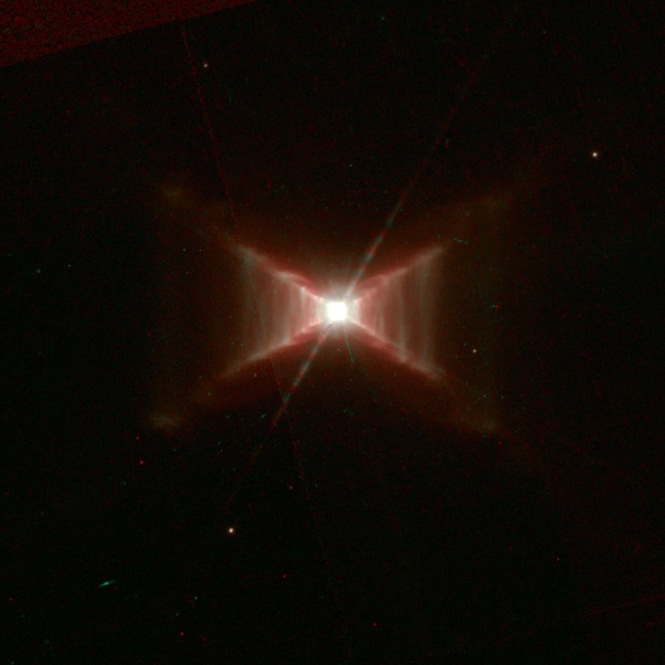I enjoy creating color images from three grayscale images. The post linked here will explain how to create color astronomical images. The colors assigned are not necessarily what the human eye would see, but are used to bring out details. Visit the gallery of previous Astro-Images. Unless otherwise noted, all images are made by me using three original grayscales from the Hubble Legacy Archive.
![]()
NGC 6445
Can an exploding star create debris in the shape of a rectangular box? It appears that is what happened with the Red Rectangle nebula. It is found in the constellation Monoceros which is just to the left of Orion. The nebula was discovered in 1973 when scientists were using a rocket to search for infrared sources. The two stars at the center of the nebula were discovered in 1915.

Consider this model of the Red Rectangle. To make it, I put an image of a wine glass stem-to-stem with another and placed them horizontal. Two stars are in orbit where the stems join. One of the stars is nearing the end of its life cycle and is emitting large amounts of gases in two directions (left and right) along the axis of spin. The excited gases appear red. This model is not viewed exactly 90˚ to the axis. The actual image above is actually 90˚ to the axis of spin.
In the image above, there are variations in the cones emitted to the left and right. They are disruptions to the flow of gases from the source star caused by the other star in orbit around the source.

![]()
NGC 6818
The Little Gem nebula is located in the constellation Sagittarius in the southern sky. The full width is about half a light year. That is small by cosmic distance standards. The bright central star is the source of the nebula material. There is a slightly darker outer shell with a lighter colored inner bubble. The inner one is expanding outward into the outer shell creating bright knots of interactions.

NGC 6720
The Ring Nebula is found in the constellation Lyra in the northern sky. I’ve seen it many times with my telescope. It is faint and rather small. This Hubble view brings out the details including the white dwarf central source star. It was discovered in January 1779 by Antoine Darquier de Pellepoix and independently by Charles Messier. It has the Messier label M57.
A Hubblecast video by the European Space Agency ESA explains some features of this unusual nebula. The blue interior is actually a football/rugby-ball shaped region. Imagine turning the ring about 90˚ to see it from the side. It would look like this.

NGC 6894
This ring nebula located in the constellation Cygnus reminds me of a sand dollar. It is greatly enlarged in this Hubble image. It is actually very small and very dim. The stars are a little too purple tinted. I couldn’t get the color balance I liked. So, I left it as is.



Always fascinating!
I’ve always liked square or rectangular-cut stones, and I like the rectangular nebula. It’s fun to imagine it set into a ring nebula. 🙂
There seem to be endless variations on how nebulae appear. Viewing position is such a big factor.
I believe I could set that cut into your ring, madam.
I’m still grinning. Your creativity apparently knows no bounds. Now that I have a cup of coffee into me and have jump-started my mind, it occurs to me to say — that ring is just heavenly!
I’m glad your day is off to a good start. May it continue.
Awesome pictures indeed!
Wonderful photos! I always learn something new when I come to ‘How I See It’. Thanks Jim and take care! Bob
I appreciate that.
The unusual rectangular nebula you’ve presented reminds me of the surprise people felt a couple of centuries ago when Fourier showed how to combine infinitely many sine and cosine functions to create waves in the shapes of rectangles, triangles, and other non-sinuous shapes.
https://en.wikipedia.org/wiki/Fourier_series
Cool stuff by Mr. F.
I see you hesitated to say the F-word: Fourier.
I love the colors, because they stand out more. I’m still interested in trying some astrophotography with my new camera and a wide angle lens. I listen to Rick Sammons podcast and he had an episode on low light photography. The lenses needed to get these really bright and starry nights need to be ultra fast, say a 24mm f/1.4 or even wider. That way you can get mostly Milky Ways, but they sure look beautiful. Check out this photographer:
(http://intothenightphoto.blogspot.com/2013/02/overcoming-coma-aberration-part-2.html)
Also, the only way to shoot the northern lights are with the wide lenses I just described.
Here is your comment. I dug it out of the spam folder. 🙂
How rude Jim! 😉
Just kidding…;)
I didn’t put it there. Blame WP. 🙂
I agree that this was a well written informative article about night sky photography lenses. I wish you success with your attempts.
I still don’t have the f/1.4 lens that is required. There are cheaper versions than the Canon ones but one needs the DSLR to make the longer exposure.
I just made a comment here and it did not show!
The comment was that I really liked the colors because they stand out more like that. The other comment was that in order to do really nice astrophotography, I need one of the fast wide angles sense, such as these:
(http://intothenightphoto.blogspot.com/2013/02/overcoming-coma-aberration-part-2.html)
Well, it had a link.
Is it still not showing?
No, but now I wonder whether it was the blog. It was a great page on astrophotography. Let me try again:
http://intothenightphoto.blogspot.com/2013/02/overcoming-coma-aberration-part-2.html
No, it’s not showing.
Are you able to try posting it again?
http://intothenightphoto.blogspot.com/2015/01/milky-way-nightscapes-ebook-preview.html
I just checked my comments in admin. Your comments were put into a spam folder. I will try to get it out.